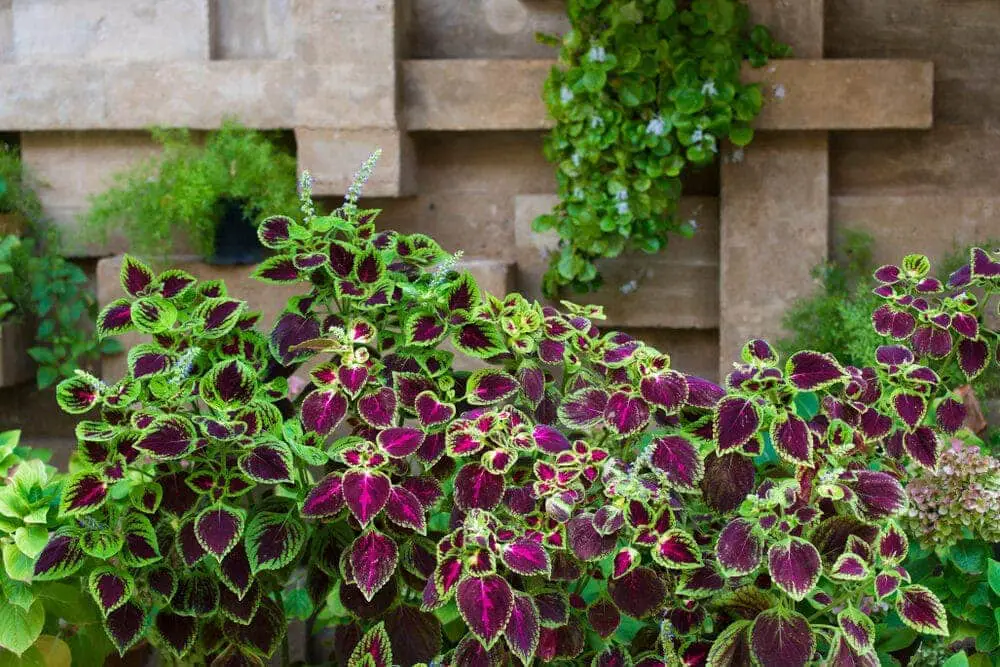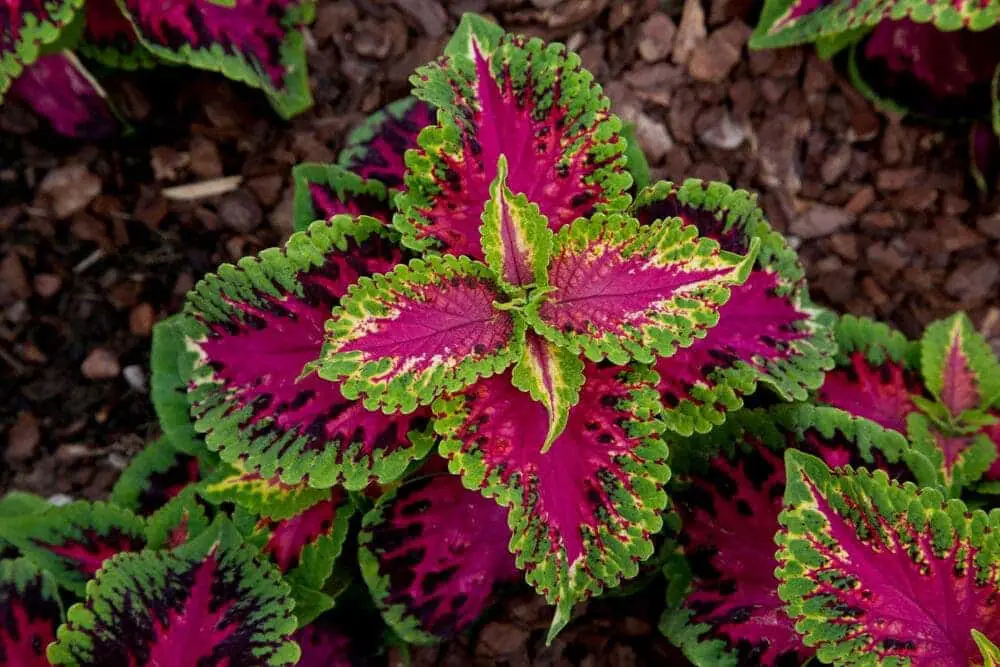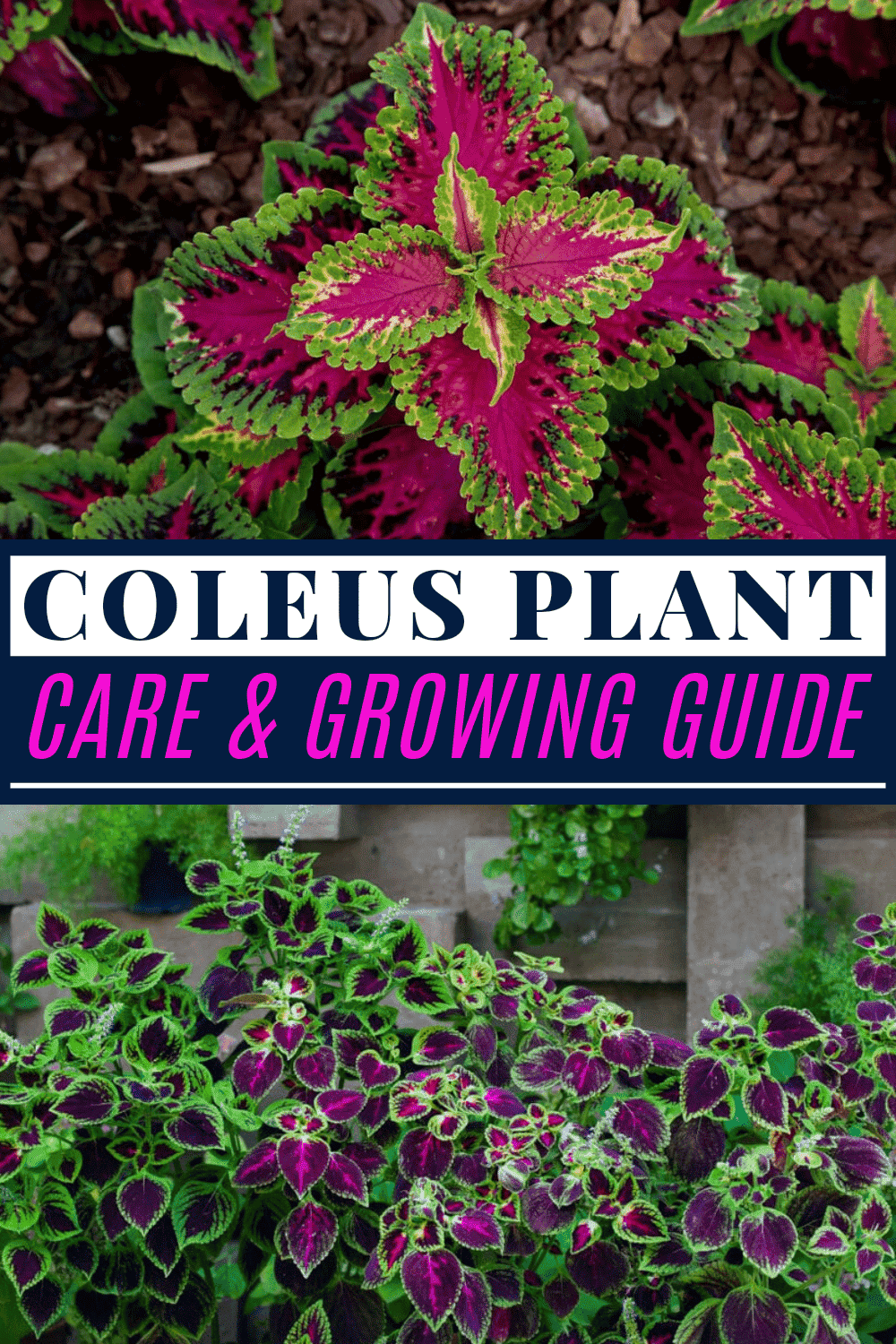The Coleus plant is rare and unique. It is generally grown exclusively for its very colorful foliage in yellow, pink, maroon, green, etc.
They have a wide variety of overall shapes and leaf sizes. These are the perfect plants for adding color indoors or outdoors. They are easy to propagate and grow.
Coleus Plant Care & Growing Guide
1. Light Requirement
The ideal spot for a Coleus Plant is one that receives afternoon shade and morning sun. The reason is that the sun is the hottest in the afternoon. The bright, full direct afternoon sunlight can scorch the leaves and bleach out the plant’s colors.
2. Water
These plants need to be kept moist, especially if they are newly planted. If you put them in containers, they will require more frequent watering. If you have them in pots, like on your porch or deck, during the hot months you need to water once or twice a day. If they are indoors, water every two or three days. It is advisable to let the soil dry between watering.
When first planting them, indoors or outdoors, give them a good soaking to saturate the soil.
3. Climate
These are generally grown by those that live north of the USDA hardiness zones 10 and 11. Make sure that if grown outdoors; you do not give it too much sun as this plant is a shade lover. If your plant starts to lose leaves, the spot where they are planted is either too cold or too dark.
4. Soil
This is a plant that thrives better in containers with the loose texture of good potting soil rather than in the ground. If you want to grow them indoors in a container, there is a different maintenance requirement. The soil needs to be moist but not wet as it is not very drought tolerant. You have to find the balance to keep it hydrated but not soggy.
When potting it, you want to use well-draining soil and the pot needs to also have good drainage.
5. Temperature
The ideal temperature would be 70-100 degrees Fahrenheit. Although it can tolerate very warm weather it cannot stand the cold. If the overnight temperature drops below 50 degrees Fahrenheit, the plant can be in trouble. If possible, repot it in a pot and bring indoors when the colder weather sets in.

6. Repotting
In time, when growing your Coleus plant in a pot it will outgrow it and need to be repotted. If you want to keep it at the size it is, then you just keep it in the same pot. If the plant is root-bound, then it will stop growing. The drawback to this is that eventually the health of the plant will suffer and you will need to give it more space.
When repotting, gently pull it out of the current pot and remove as much of the soil as you can, but make sure that you do not harm the roots. If you find it partially pot bound, gently massage the roots between your fingers. This will encourage the roots to spread out in the new one and continue to grow.
You want the new pot to be about two inches in diameter and height more than the older pot. Put enough potting soil in the bottom of the new pot so it is at the same level as it was in the older pot. Put the plant in the center of the container and fill it with soil.
7. Speed of Growth
From seeds, it can take ten to twenty days to germinate and at first, they start growing slowly.
8. Height and Spread
Normally, the largest coleus will only reach from six inches to three feet and range from one to three feet wide. The leaves range from one to six inches long.
9. Flowers
The flowers are usually whitish-blue but the leaves are what are more colorful. The color of the leaves will depend on the type of Coleus plant. They can be purples, greens, reds, and more.
10. Trimming
Pruning, or trimming, is important. If you do not do this regularly, it can cause them to become leggy and unattractive. By pruning them regularly it will help to keep them bushy. Cut off any blooms so the Coleus plant will put its energy into the beautiful foliage. If they get too tall you can behead them at the top.
By doing this, it will encourage it the plant to get denser foliage and bush outward. If there is excessive legginess, move the container to where it gets more sunlight.
Is the Coleus Plant Poisonous?
For a cat or dog, they are very poisonous, even if they brush up against the leaves or flowers. There is a toxic essential oil the plant puts out that is poisonous. They are non-toxic to humans.

Can Coleus Plants grow in Water?
The answer is two-fold. Using just a glass of water you can start your cuttings of the Coleus Plant. They root easily, but to grow, they need to be planted outdoors or in a pot with good soil.
How to get Coleus Plants to Flower?
To help them produce a bushier growth, you can pinch the shoots.
Keep reading: Rhipsalis Care & Growing Guide
Common Coleus Plant Diseases
The Coleus Plant are prone to various diseases, including:
- Root rot—this can happen if it is watered too heavily. If this happens, the roots will be destroyed and the plant will not be able to absorb nutrients or water. To prevent this do not overwater.
- Downy mildew—this is a fungal disease spread by airborne spores. To get rid of this, mix two tablespoons of each of these; baby shampoo, cooking oil, and baking soda in a gallon of water. Use this mixture to spray the leaves.
- Pests—sometimes they can be attacked by mealy bugs. These can be gotten rid of by using 70% rubbing alcohol on a cotton ball and rubbing it over the leaves to kill the bugs.
- Sunscald—this is caused by being in direct sunlight all the time. To prevent this, keep it out of direct sunlight and in the shade during the hottest part of the day.
Also read:
Conclusion
- They can be propagated indoors from seeds in 8-10 weeks before the last expected frost.
- They can be grown in containers or added to borders or beds
- Need fertile, well-draining soil and do best in partial shade areas although some varieties can tolerate sun.
- The Coleus plant is a tender annual so in the winter it has to be brought indoors for overwintering.
- Fertilize regularly with a slow-release fertilizer with the potting soil if potting indoors.

Victoria is the owner and main author of hobby plants. She loves spending her free time in her garden planting and taking care of her plants. Victoria hopes you enjoy the content here!
![Do Coleus Like Sun Or Shade: [Complete Care Guide] Do Coleus Like Sun Or Shade: [Complete Care Guide]](https://www.hobbyplants.com/wp-content/uploads/2022/08/coleus-sun-or-shade-300x158.jpg)
![Mother Of Thousands Plant [Complete Plant Care Guide] Mother Of Thousands Plant [Complete Plant Care Guide]](https://www.hobbyplants.com/wp-content/uploads/2022/07/mother-of-thousands-plant-300x158.jpg)
![Majesty Palm Plant Care: [Complete Beginner's Guide] Majesty Palm Plant Care: [Complete Beginner's Guide]](https://www.hobbyplants.com/wp-content/uploads/2022/08/majesty-palm-care-300x158.jpg)
![Exotic Angel Plant Care: [Complete Beginner's Guide] Exotic Angel Plant Care: [Complete Beginner's Guide]](https://www.hobbyplants.com/wp-content/uploads/2022/08/exotic-angel-plant-care-300x158.jpg)
![Snow White Waffle Plant: [Complete Care Guide] Snow White Waffle Plant: [Complete Care Guide]](https://www.hobbyplants.com/wp-content/uploads/2022/08/snow-white-waffle-plant-300x158.jpg)
![Waffle Plant Care: [Complete Beginner's Guide] Waffle Plant Care: [Complete Beginner's Guide]](https://www.hobbyplants.com/wp-content/uploads/2022/08/waffle-plant-300x158.jpg)
![Bird Of Paradise Plant Care: [Complete Beginner's Guide] Bird Of Paradise Plant Care: [Complete Beginner's Guide]](https://www.hobbyplants.com/wp-content/uploads/2022/08/bird-of-paradise-plant-300x158.jpg)
![Purple Passion Plant Care: [Complete Beginner's Guide] Purple Passion Plant Care: [Complete Beginner's Guide]](https://www.hobbyplants.com/wp-content/uploads/2022/08/purple-passion-plant-care-300x158.jpg)
![China Doll Plant Care: [Complete Beginner's Guide] China Doll Plant Care: [Complete Beginner's Guide]](https://www.hobbyplants.com/wp-content/uploads/2022/09/china-doll-plant-care-300x158.jpg)
![Polka Dot Plant Care: [Complete Beginner's Guide] Polka Dot Plant Care: [Complete Beginner's Guide]](https://www.hobbyplants.com/wp-content/uploads/2022/09/polka-dot-plant-300x158.jpg)
![Mona Lisa Lipstick Plant Care: [Complete Beginner's Guide] Mona Lisa Lipstick Plant Care: [Complete Beginner's Guide]](https://www.hobbyplants.com/wp-content/uploads/2022/09/lipstick-plant-mona-lisa-300x158.jpg)
![Yucca Cane Plant Care: [Complete Beginner's Guide] Yucca Cane Plant Care: [Complete Beginner's Guide]](https://www.hobbyplants.com/wp-content/uploads/2022/09/yucca-cane-plant-care-300x158.jpg)